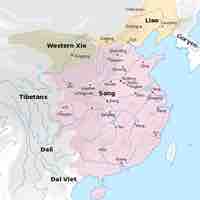Chapter 14
Chinese Dynasties
By Boundless
The Tang dynasty, generally regarded as a golden age of Chinese culture, was founded by the Lǐ family, who seized power during the decline and collapse of the Sui dynasty.
By reopening the Silk Road and increasing maritime trade by sail at sea, the Tang were able to gain many new technologies, cultural practices, rare luxuries, and foreign items.
Religion in the Tang dynasty was diverse, and emperors sought support and legitimation from some local religious leaders, but persecuted others.
Scholar-officials, also known as the Chinese literati, were civil servants appointed by the emperor of China to perform day-to-day governance, and came into special prominence during the Tang dynasty.
After the difficult suppression of the An Lushan Rebellion, the jiedushi increased their powers and accelerated the disintegration of the Tang dynasty.
The Song dynasty was an era of Chinese history that began in 960 and continued until 1279; it succeeded the tumultuous Five Dynasties and Ten Kingdoms period and saw many technological and cultural innovations.

During the Northern Song (960-1127), the Song capital was in the northern city of Kaifeng, and the dynasty controlled most of what is now Eastern China.
The Southern Song (1127–1279) was the period after the Song lost control of its northern half to the Jurchen Jin dynasty in the Jin–Song Wars and retreated south of the Yangtze, establishing a capital at Lin'an.
Social life and culture during the Song was vibrant and diverse, with important achievements in the arts and lively popular entertainment.
The Song dynasty provided some of the most significant technological advances in Chinese history.
The Yuan dynasty was founded by Kublai Khan, leader of a major Mongolian clan who invaded China but adopted many Chinese customs and practices.
During the Yuan dynasty, trade flourished and peace reigned along the newly revived Silk Road, contributing to a period known as the Pax Mongolica.

After years of internal struggle, famine, and diminishing territorial control, the Yuan dynasty was defeated by the rising Ming dynasty in 1368.
The Ming dynasty was founded by the peasant rebel leader Zhu Yuanzhang.
The economy of the Ming dynasty was characterized by extreme inflation, the return to silver bullion, and the rise of large agricultural markets.
Trade during the Ming dynasty began slowly, with severe restrictions, especially toward Japan, but later expanded to markets around the world.
Literature, poetry, and painting flourished during the Ming dynasty, especially in the economically prosperous lower Yangtze valley.
The fall of the Ming dynasty was caused by a combination of factors, including an economic disaster due to lack of silver, a series of natural disasters, peasant uprisings, and finally attacks by the Manchu people.